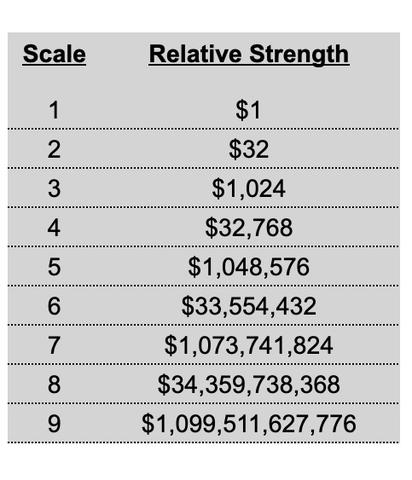We don’t have hurricanes or tornadoes, but we should all know more about our biggest threat; earthquakes
By Morf Morford
Tacoma Daily Index
We have earthquakes almost every day in the greater South Sound area. Most of them are tiny, many miles deep and far away – mostly in the mountain ranges.
When we do hear of them, they are described “logarithmically” – which only adds to their mystery.
Since the Richter scale is “logarithmic” it’s hard to get a sense of how much more powerful earthquakes get as they move up the scale.
In terms of energy released, each one point move up the Richter scale is 32 times more powerful than the previous number. The chart below shows what this looks like in terms of dollars, starting with 1 being just $1.00. For a little perspective, the July 3, 2019 earthquake outside of Los Angeles was a 6.4 on the Richter scale. The second, larger one which struck on July 4, 2019 was a 7.1. This sounds like it was just a little stronger; when in fact, 11 TIMES more energy was released.


The Nisqually quake that hit us in 2001 was a 6.9. It shook most areas for about 15 seconds – but did millions of dollars in damage.
The March 2011 Tohoku quake which created the tsunami that destroyed the city and nuclear facility at Fukushima, Japan and killed over 16,000 people, was a 9 on the Richter scale.
A 9 is the predicted strength of “The Big One” a predicted quake in the Cascadia Subduction located just off the coast of the Pacific Northwest.
A quake of 9 would be over 2,000 times stronger than the Northbridge quake that occurred 25 years ago in the San Fernando Valley region of Los Angeles.
If you want to do your own Richter Scale calculations go here – https://earthquake.usgs.gov/learn/topics/calculator.php.
If you’d like to see a graphic display of the earthquakes in California from 1989-2019, check out this video by NOAA and NWS – https://www.youtube.com/watch?v=qYgz1OCbeu8&feature=youtu.be&fbclid=IwAR3Bf512igk780GEWGLqbnGNA6duLr40f9sM_l8WV8OIxnwog0OkZv6ZaNE.
If you’d like to check out the continuing impact of an earthquake in Washington state a few centuries ago, look here – https://www.youtube.com/watch?v=K_sJ0QJ31fc.
If you want to follow tremor developments locally and around the world, I suggest the Facebook group Pacific Northwest Earthquake Discussion Group –https://www.facebook.com/groups/thePNSN/.
You could also keep an eye on the USGS website for a continually updated map of earthquakes here – https://earthquake.usgs.gov/earthquakes/map/.


Prepare your kids for emergencies
Talking to your child about what to do in the event of any emergency is essential – and perhaps nothing is as unnerving as an earthquake.
Feeling your world shake under your feet is a sensation no one gets used to.
As with adults, the trick is to not panic but do something concrete.
Here are some tips to help kids deal with the unpredictable event in their lives:
First of all, listen. Find out what children know – or what scares them the most – about disasters and let them express their feelings.
Be honest. Tell the truth in an age-appropriate way. Don’t overwhelm them with too much information. If you don’t know something, let them know you’ll find the answer.
Be reassuring. Acknowledge that disasters can be scary. Let them know you’re taking safety precautions and that you’ll show them what they should do.
Don’t show children frightening pictures of disasters when talking about safety. Your focus should be on what you can do – not the worst possible outcome.
Make it a learning experience. Instead of focusing on the negative aspects of disasters, play to children’s curiosity and make the topic educational. Use games and cartoons to help them learn.
Talk about helpers. Highlight the people who often serve others in daily life and during disasters, and talk about the ways your children also can help.
Empower and equip them. Invite children to participate in the family’s emergency preparations.
Earthquakes can happen at any time, and it might not seem like it, but they pass quickly.








